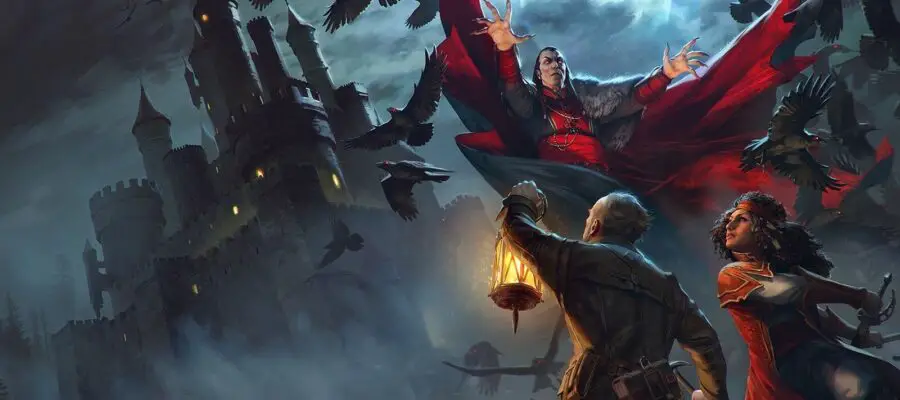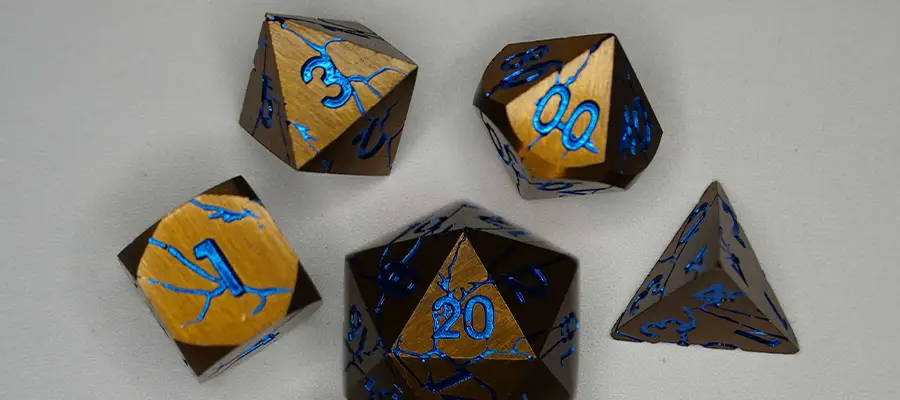Featured image credit WotC @ Van Richten’s Guide to Ravenloft.
Disclaimer: This article contains affiliate links that add gold to our coffers.
Ahead, the swirling fog beckons. Behind, a lurking darkness hungers. Will you remain and be devoured? Or step forward—and lose yourself in the mists?
Van Richten’s Guide to Ravenloft presents 5e Dungeon Masters with an updated version of Ravenloft, a Dungeons & Dragons horror campaign setting that has enraptured DMs and players since AD&D. While DMs may buy this book expecting an encyclopedia of Ravenloft lore, Van Richten’s Guide is best viewed as an expansive guide to tabletop horror, supplemented with Ravenloft elements and atmosphere. In doing so, Van Richten’s Guide provides an assortment of new (and old) Ravenloft lore, a suite of DM resources, and a collection of intriguing player options.
Ravenloft Lore
Ravenloft is a prison, a realm of mist and shadow in which Darklords—villains of unspeakable evil—are contained and tormented by the mysterious and omnipotent Dark Powers. Each Darklord resides in a personal Domain of Dread, which forms a personalized Hell for its ruler. From time to time, the mists of Ravenloft entrap unwitting victims from across the multiverse. Savvy adventurers can navigate the ways between Domains, but escape from Ravenloft itself is nigh-impossible.
Van Richten’s Guide to Ravenloft brings Ravenloft to 5th Edition, providing thirty-nine Domains (seventeen of which are fully fleshed out) and Darklords to populate a campaign of horror. These Domains include:
- Barovia, the sunless land of the vampire lord Strahd von Zarovich
- Falkovnia, in which a cruel and brutal general leads her troops to slaughter at the hands of an eternal zombie apocalypse.
- I’Cath, a domain in which all residents must choose: survive on scraps in a crumbling city, or become a mad queen’s slave in a never-ending dream.
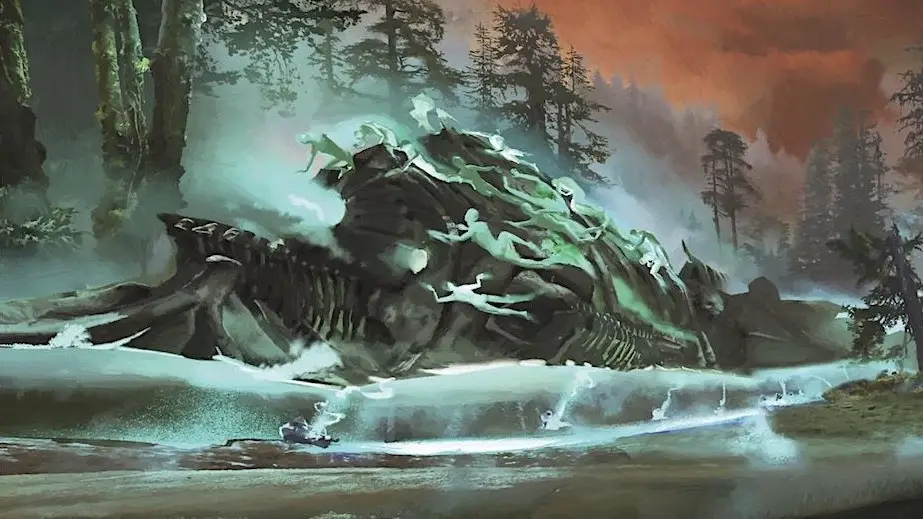
From the Lovecraftian Bluetspar to the intrigue-infested Borca and the haunted ghost train Cyre 1313 (”The Mourning Rail”) these horrific realms are evocative and interesting places. Though each realm is a Darklord’s prison, they are also settings in their own right, presenting hooks for exploration and adventure beyond Curse of Strahd’s villain-centric story. The isolated Domains may now drift alone through the mists, but Ravenloft’s 5e rendition is remarkably coherent, providing equal support for a series of independent horror romps or an epic campaign seeking escape from the Dark Powers’ grasp.
The “Travelers in the Mists” described in the book, such as the occultist Keepers of the Feather, the mysterious wanderer Firan Zal’honan, and the students of famed monster hunter Dr. Rudolph van Richten, gives DMs a colorful suite of NPCs and factions to enhance any session. When combined with the book’s diverse portfolio of horror, few DMs will finish this book feeling uninspired.
Some traditional Ravenloft fans will doubtless be disappointed to find discrepancies from past lore. The Carnival, 2e’s travelling band of horror, no longer terrorizes visitors with supernaturally disfigured “Freaks” (though this is probably for the best). Darkon, the realm of the lich-king Azalin Rex, now faces apocalypse following its Darklord’s disappearance. No longer is Dementlieu ruled by a master manipulator; instead, its residents must play a never-ending charade of fairy-tale nobility—where exposure means death.
While most lore changes are benign, the histories of several Darklords have suffered greatly. In Barovia, the vampiric conqueror Strahd von Zarovich was now lured into evil by the cult of the Priests of Osybus. In Lamordia, the “punishment” of mad scientist Viktra Mordenheim is now offset by her subjects’ love and adoration. In Har’Akir, the ancient mummy Ankhtepot is now eternally tormented for the horrific crime of deposing an unpopular and unworthy monarch.
Several Domains even bury or divide their Darklords’ histories, forcing readers to assemble their lore like pieces of a puzzle. While this was likely a deliberate decision to frame the Domains—not the Darklords—as the true “meat” of the setting, the Darklords’ intimate connection to the lands they rule makes this a questionable decision.
DM Resources
While the lore of Van Richten’s Guide is creative but lackluster, the book truly shines in its role as a supplement to the Dungeon Master’s Guide. Its thirty-six tables of horror ideas—across more than six genres of horror—make it an invaluable source of inspiration. The book doesn’t pull its punches, either: its Body Horror tables are artistically gruesome, and its Dark Fantasy section may leave you decidedly unsettled.
The book’s thirty-one new monsters—including psionic inquisitors, nosferatu, and the disgusting “zombie clot”—evoke horrific beasts from a diverse array of sources. Each statblock tells its own story, from the Bodytaker Plant’s Invasion of the Body Snatchers to the Star Spawn Emissary’s homage to The Thing. The monsters’ mechanics feel innovative and fresh: the headless Dullahan can behead its target on a critical hit; the magic-touched gremishka can cause a single spell to erupt in chaos; and the Unspeakable Horrors present endless opportunities for customization. Mythic Actions also make a triumphant return, suggesting that the innovations of Mythic Odysseys of Theros are here to stay.
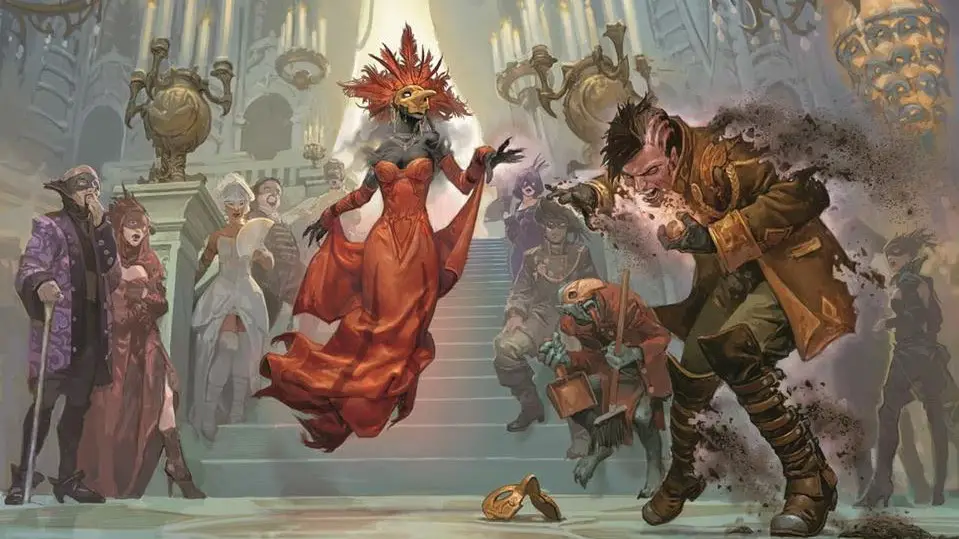
The book has one glaring omission: It fails to provide new statblocks for the Darklords of Ravenloft. Instead, DMs are advised to tweak generic Monster Manual statblocks to suit their own purposes. Many will be understandably disappointed, but Van Richten’s Guide more than makes up for it, providing a robust—and generalizable—guide to monster design and presentation. With its vigorous discussion of monster origins, tactics, and customization, this section would fit neatly into the Dungeon Master’s Guide, making it a valuable read for any DM.
DMs looking to turn curses—a cornerstone of D&D—into mechanics need look no further than the “Horror Toolkit” section, which also presents new “Haunted Traps” and a revised (and surprisingly resonant) Fear and Stress system. New “Dark Gifts” mix strengths and drawbacks to provide a unique array of player features, such as a living shadow, memories of past lives, or a symbiotic parasite. These Dark Gifts’ mechanics, like many of the book’s offerings, are easily repurposed in non-horror campaigns as well.
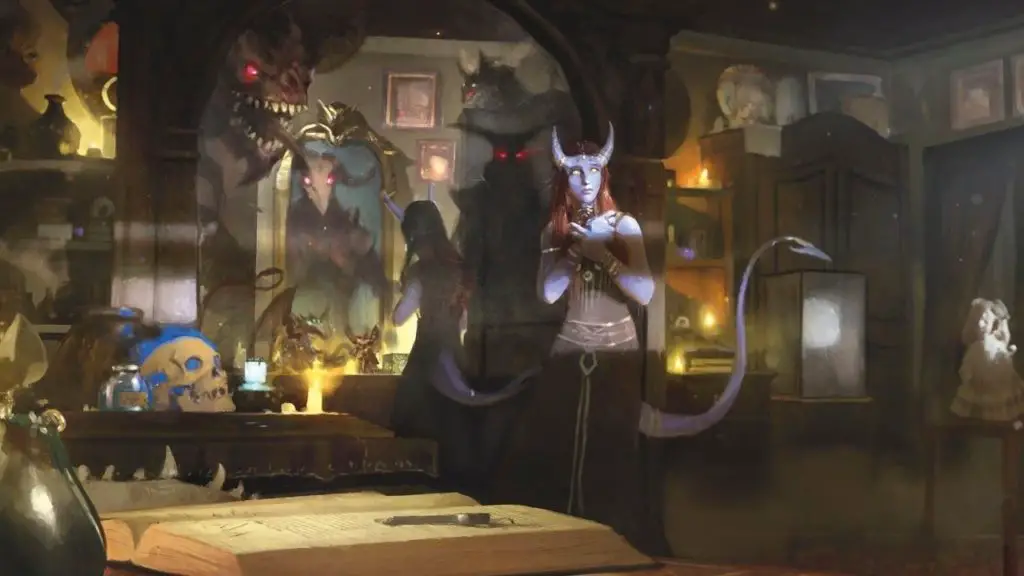
For DMs looking to up their game, Van Richten’s Guide presents a gold mine of tips on pacing sessions, crafting atmosphere, building thematic narratives, constructing villains, and managing players at the table. The book also helps DMs avoid hidden minefields, giving robust and well-written suggestions on avoiding problematic tropes, respecting player consent, and avoiding player triggers. For DMs seeking a Ravenloft on-ramp, the book’s premade adventure—”The House of Lament”—is a classic ghost story with an intriguing history, a cast of recurrable NPCs, and a thrilling final act.
Player Resources
While Van Richten’s Guide is primarily a DM-oriented product, it provides several new options for 5e players, including two new subclasses, three new races (or “lineages”), and several new background features.
The new College of Spirits subclass allows bards to channel the spirits of the dead through stories, a flavorful mechanic with an array of interesting powers. Unfortunately, bards can’t summon these powers at will, marring the subclass’s flagship feature with an unpleasant sense of gambling. (The optimal strategy: spamming short rests until you roll the Spirit Tale you want). The subclass’s Spiritual Focus feature also seems to have a typo, stopping its healing-buffing ability from improving common spells like cure wounds and healing word. Still, the new Spirit Session feature, which allows bards to gain new necromantic or divinatory spells through seances with the dead, is a joy to roleplay and a real treat for toolbox-minded players.
The Warlock’s new Undead patron comes off far better. A flavorful replacement to the oft-panned Undying patron, its dark alter ego, necrotic energies, astral projection, and death-fueled explosion make it an alluring choice for any player who’d like to dabble in the occult.
The three new lineages are intriguing as well. No longer must Curse of Strahd DMs suffer as Castlevania-loving players demand the right to play a level-one vampire: The Dhampir, a half-vampire, provides a suite of vampiric racial features alongside an enjoyable mix of unholy hungers, from blood to dreams to spinal fluid. The new Reborn lineage, which faintly resembles the Revenant race from 4th Edition, gives PCs the traits of the undead and the knowledge of lives once-lived. The third lineage—the Hexblood—is perhaps the most interesting and original, blessing hag-touched characters with “hex magic” and eerie fey abilities (including a particularly evocative hag-like feature that can be activated by ripping out one’s own tooth).
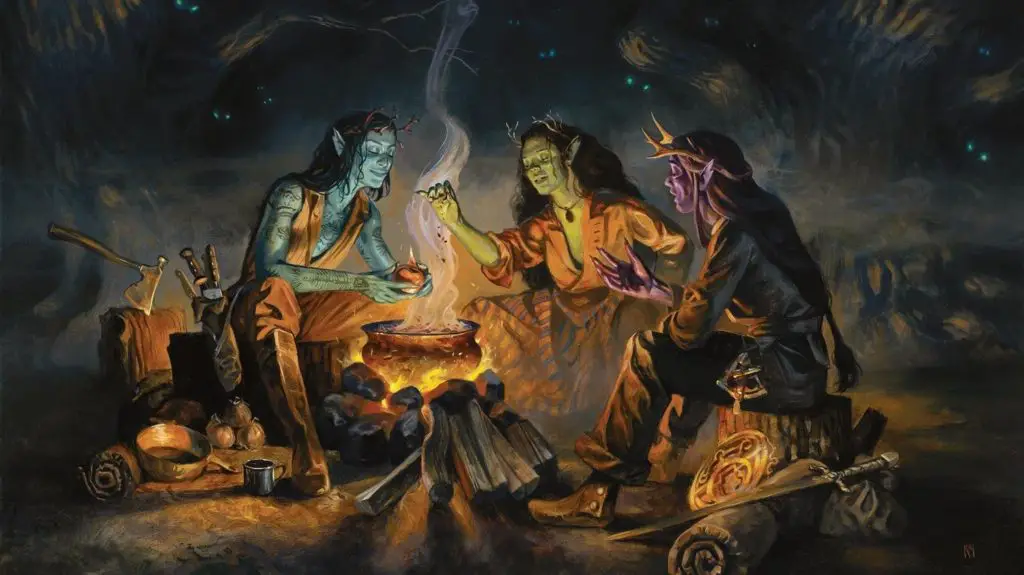
These options are supplemented by new “Haunted Heroes” guidelines, which serve as Wizards’s first foray into the player’s side of Session Zero. DMs everywhere will rejoice as Van Richten’s Guide teaches players how to communicate their boundaries, find the proper mindset to engage in the DM’s campaign, explore fears and moral ambiguities, and make the most of the horror experience. When combined with the new optional background features—modular traits like “Spirit Medium,” “Trauma Survivor,” or “Mist Wanderer” that can be swapped into any existing background—these resources highlight Van Richten’s Guide’s willingness to challenge reader expectations.
Conclusions
Van Richten’s Guide to Ravenloft doesn’t much resemble past setting sourcebooks. Eberron: Rising From the Last War merely dabbled in noir storytelling, and the Guildmaster’s Guide to Ravnica offered little beyond an encyclopedia of lore, an assortment of new monsters and mechanics, and a scattering of player options.
In contrast, while Van Richten’s Guide poses as a setting guide, its true goals are far more ambitious. Here, the setting is merely a vessel for a dizzying array of valuable tips and toolsets. Where copies of the Sword Coast Adventurer’s Guide are likely to languish on readers’ shelves, Van Richten’s Guide to Ravenloft demands active engagement, training DMs’ skills even as it fuels their inspiration.
The lore of Ravenloft is occasionally lackluster, yes, but the Domains themselves are original and thought-provoking. Old-timers seeking a Return to Ravenloft will likely be disappointed, as will DMs hoping for a fully fleshed-out setting. Yet new DMs can find invaluable lessons here, and those running horror-adjacent modules—from Descent into Avernus to Rime of the Frostmaiden and Curse of Strahd itself—will doubtlessly find something to love within its pages. The Ravenloft setting itself is reasonably robust as well; unlike Wildemount, few parties will prefer to run multiple campaigns here, but a campaign that takes characters from level 1 to 20 is remarkably feasible.
Looking for a spooky one-shot? Spirit your players away onto the front lines of a zombie siege, the jungle haunts of a werepanther stalker, or the skull-rimmed balconies of the osseous Tower of Traitors. Hoping for a longer campaign? Summon your players to the dreadful House of Lament, then let them wander the Domains of Dread as they investigate the mystery of Firan Zal’honan, learn the lore of the Keepers of the Feather, make allies of Dr. Rudolph van Richten and his loyal students, and encounter colorful figures from the demonic Caller to the repentant vampire Jander Sunstar. Perhaps, one day, they shall even catch a glimpse of the worlds from whence they came.
What Ravenloft stories will you and your players tell? Speak softly, for the Dark Powers are surely listening.
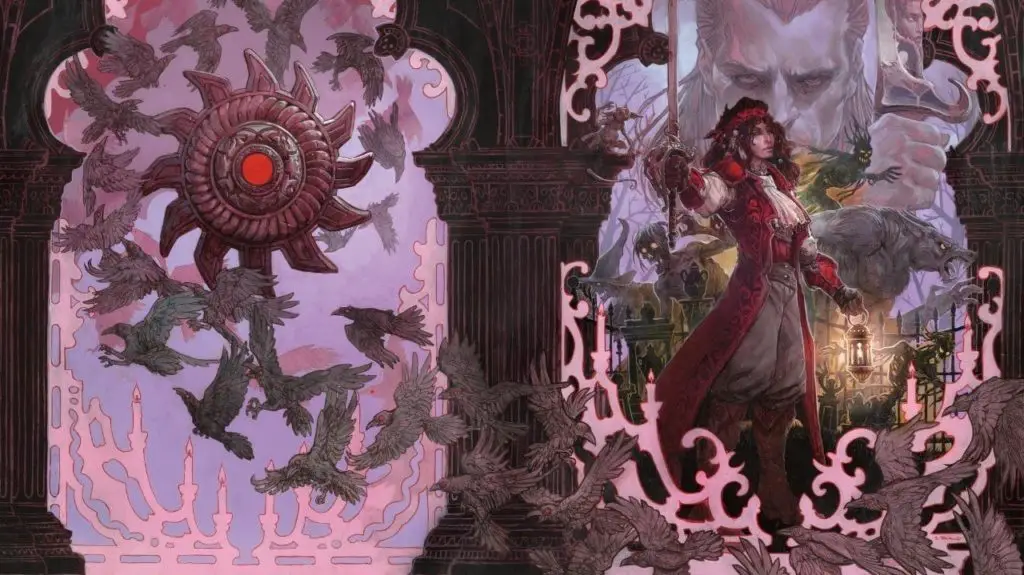
Van Richten’s Guide to Ravenloft can be purchased from your local game store, through online retailers, or through Wizards of the Coast’s digital partners. Click here to learn more.
About the Author: DragnaCarta is a guest writer for FlutesLoot.com and a veteran DM with 12+ years of experience. He is the author of the popular “Curse of Strahd: Reloaded” campaign guide and the Dungeon Master and director for the Curse of Strahd livestream “Twice Bitten.” You can get his personal RPG mentoring plus early access to projects by joining his Patreon.
Cast Message in the comments section below to ask DragnaCarta about Van Richten’s Guide to Ravenloft. You can find other articles by DragnaCarta on FlutesLoot.com:

